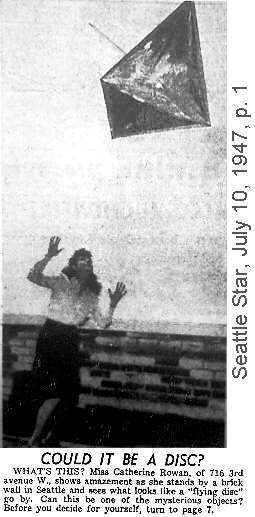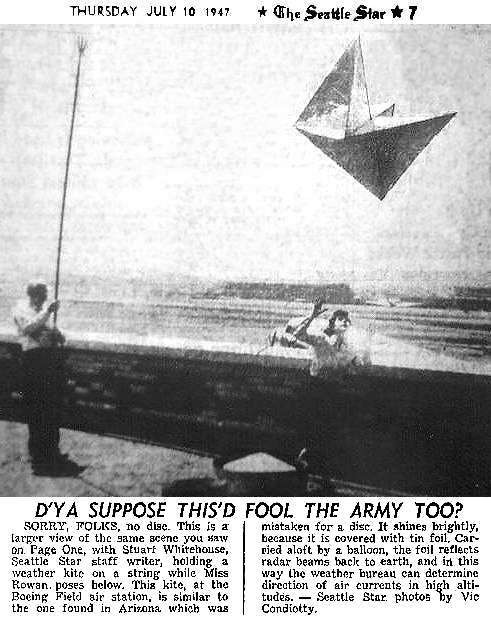July 10, Seattle Post-Intelligencer, page 3
BALLOON MAY SEEM DISK-LIKE
--Could These Be Taken For Flying Saucers?
Among airborne objects which Pacific Northwest residents may mistake for the elusive flying disks from time to time are observation balloons released daily by the weather bureau.
Pilot balloons used to check wind currents are released four times daily at 15 different points, in all types of weather. These attain great heights, are from 18 inches to three feet in diameter, and painted various colors.
None of them are silver, the weather bureau said yesterday. They may, however, move in an erratic fashion if caught in turbulent air. Usually they rise straight upward and are soon lost to sight.
OTHER TYPES
Bigger than these, but less numerous, are the radiosonde balloons which carry small transmitters that broadcast temperature, pressure and humidity readings.
Radiosonde, or "raob" (radiosonde observation) balloons are released at 7 a.m. and 7 p.m., at Tatoosh Island, Sand Point Naval Air Station, Spokane, Medford, Ore., and Boise, Idaho.
Ceiling balloons, used to measure the height of low clouds, are released less frequently. These are small, and are soon lost in the overcast.
Weather bureau men expressed doubt yesterday that ceiling balloons would be sighted high enough to be mistaken for disks.
2nd Photo Caption: LIKE DISKS Shown leaving the weather tower at Sand Point Naval Air Station is a radiosonde balloon, which at high altitude bears some resemblance to objects widely reported as flying disks. Numbers show (1) hydrogen-filled balloon, about four feet in diameter, which carries equipment above 60,000 feet; (2) parachute, used to lower equipment when balloon bursts at high altitude; (3) spreader ring to keep parachute shrouds from tangling, and (4) radiosonde transmitter, which flashes signals recording temperature, humidity and pressure to weather station receiver, where information is recorded on charts. Equipment found on New Mexico ranch and first thought to be a disk was "ray wind" equipment, different from radiosonde apparatus. However, balloons which carry two sets of equipment are similar. (Post-Intelligencer Photos by Ed Watton.)
July 9, Seattle Star, Front Page
(accompanied main UP Roswell story)
WEATHERMEN DOUBT KITES ARE 'DISCS'
The Seattle station of the U.S. Weather Bureau today said "a few" shiny kites are released for it from ships at sea, and occasionally one is launched at Vancouver, B.C., but forecasters doubt there are enough adrift to account for all the flying discs reported seen in the Pacific Northwest.
"They don't exactly 'speed across the sky'," the spokesman said. "They're attached to balloons and blown by the wind."



